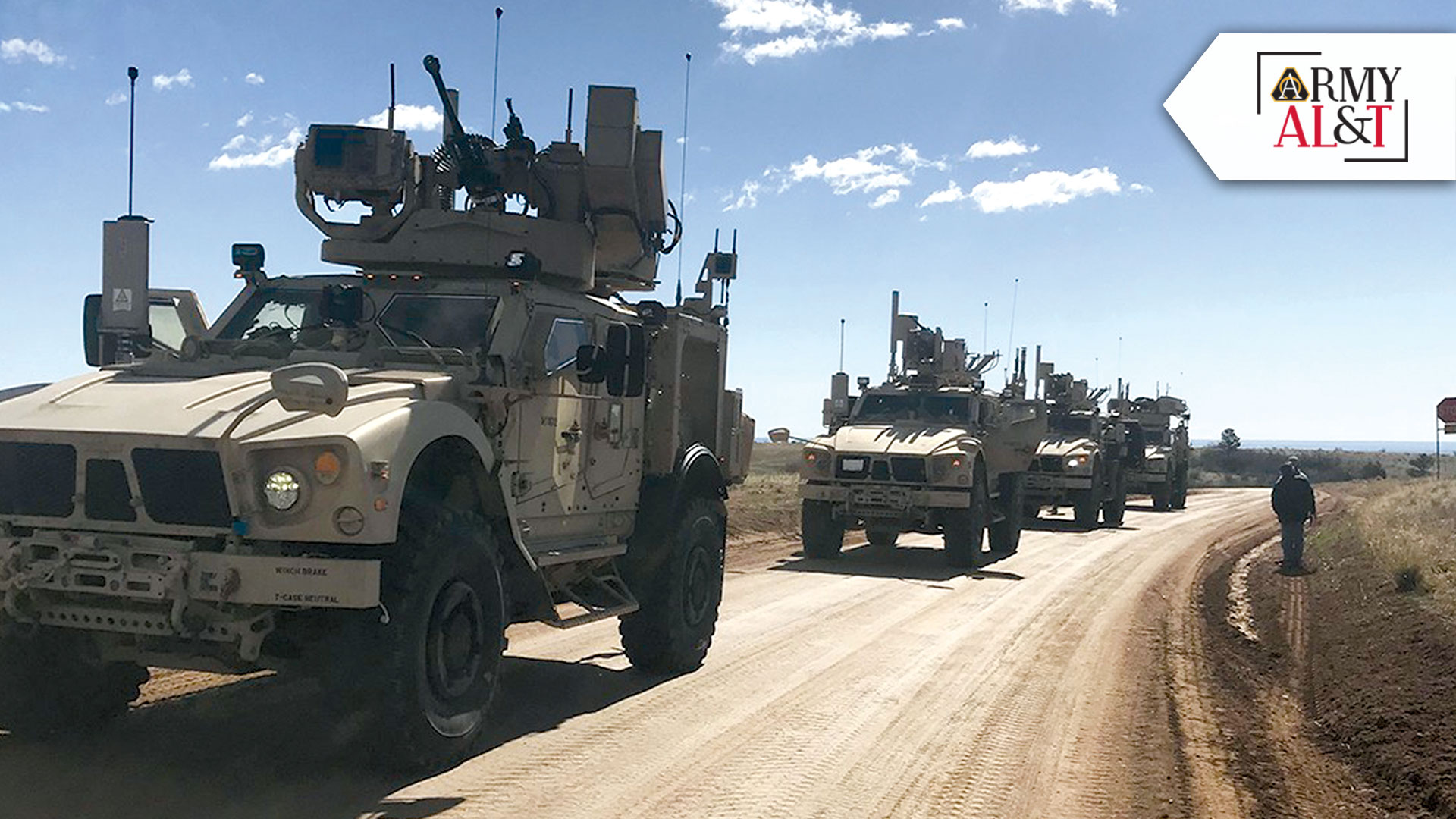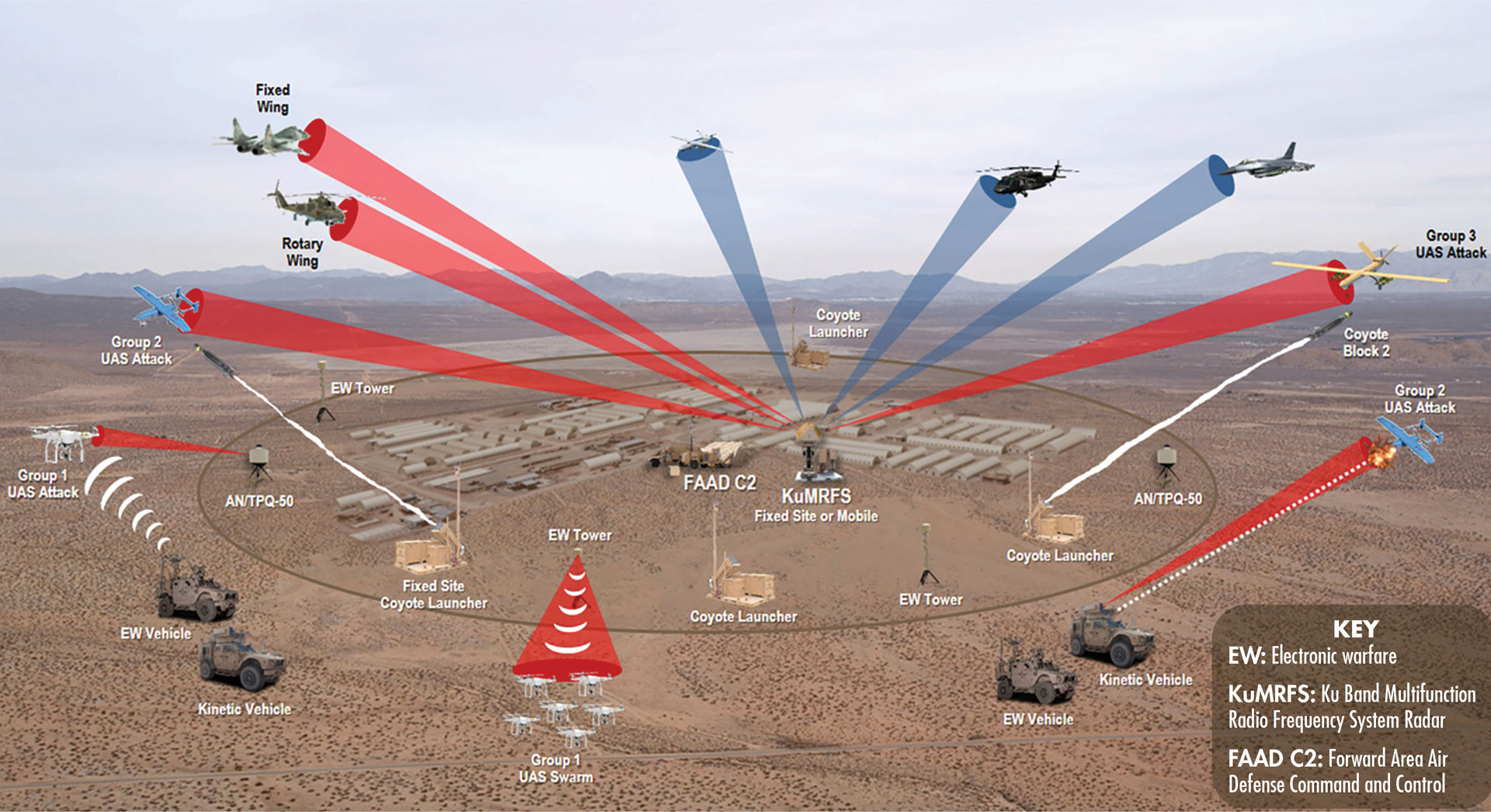
LIDS TAKES OFF: Commercial off-the-shelf drones have already been deployed to deadly effect in combat, which explains why so many international allies and partners have shown interest in LIDS. (U.S. Army Photo)
A demonstration of counter-unmanned aircraft systems solutions generates interest from 16 foreign partners.
by Meghan E. Hall
When a Soldier encounters an adversary’s unmanned aircraft system, hovering just outside her foxhole, she can either hope she wasn’t seen, or she can deploy LIDS to incapacitate it—disabling the electronics and even shooting it right out of the sky—and not have to worry. The combat successes of the Low-Slow-Small Unmanned Aircraft System (UAS) Integrated Defeat System (LIDS) have generated international interest in the system as a deterrent to small UAS outside of traditional air defense system capabilities. LIDS was developed by Integrated Fires/Rapid Capabilities Office (IF/RCO) in the Program Executive Office (PEO) for Missiles and Space. To showcase the system capabilities, IF/RCO hosted an International Demonstration Day on Aug. 18 during routine testing at Yuma Proving Ground, Arizona.
SYSTEM COMPONENTS
The demonstration featured fixed-site LIDS (FS-LIDS), which includes the Forward Area Air Defense Command and Control, counter unmanned aircraft electronic warfare system, electro-optical infrared camera, direction finding sensors, mesh-net Internet Protocol radios, and the AN/TPQ-50 Multi-mission Radar. For kinetic defeat, FS-LIDS employs a Ku Band Multifunction Radio Frequency System Radar and Coyote Block 2 Interceptor. The U.S. Government also exhibited Mobile LIDS (M-LIDS), which is equipped with all five LIDS capabilities, plus a 30 mm chain gun that are all integrated into mine resistant ambush protected all-terrain vehicles.
The LIDS family of systems uses a modular framework with a cutting-edge capability, overlaid on existing programs of record, to create a mechanism to defeat UAS from the smallest systems to Group 3 unmanned aircraft capable of carrying large explosives or sophisticated observation payloads. These aircraft typically weigh more than 55 pounds, but less than 1,320 pounds and operate below 18,000 feet at speeds of slower than 250 knots—like the Shadow and the Integrator.

THE PERFECT OPPORTUNITY: Adversaries will use swarms of small, cheap, scalable and disposable unmanned systems both offensively and defensively, creating targeting dilemmas for C-UAS. This creates the perfect opportunity to employ a UAS solution—like LIDS. (Photo by Spc. Destiny Jones, U.S. Army)
THE DEMONSTRATION
To demonstrate the full range of the system, the Army conducted eight scenarios: three used the Counter Unmanned Aircraft Electronic Warfare System, two used the XM914 30 mm cannon with proximity fused ammunition, and three used the Coyote Block 2 Interceptor. Threats included single flights and swarms in multiple configurations. All of these scenarios used Forward Area Air Defense Command and Control to provide command and control, engagement operations, situational awareness and automated air-track information to support multiple simultaneous missions with electro-optical infrared sense support from the Nighthawk camera.
Foreign partners noted the Coyote’s automatic re-attack capability, which enhances “probability of kill” for each round fired. The detonation associated with the terminal engagement of the kinetic kills, while impressive, is only part of the capabilities available for the LIDS family of systems. The counter unmanned aircraft electronic warfare system provides an extra layer of defense for integrated kinetic weapon systems and has the ability to mitigate swarms of UAS in multiple configurations.

LIDS CONCEPT: The LIDS family of systems uses a range of passive and active sensors to detect, track and identify UAS and non-hostile aircraft. LIDS uses a comprehensive network to communicate, allowing the operator to task appropriate mitigation techniques, ranging from electronic warfare to full physical intercepts. (Graphic by IF/RCO, U.S. Army)
IN MODERN WARFARE
The number of commercial off-the-shelf drones and the availability of kits and online tutorials to build drones out of easy-to-find items, means that counter unmanned aircraft systems (C-UAS) must be modular, open architecture and scalable to evolve with the threat. Both terrorist organizations and nation states have used weaponized drones to inflict damage ranging from targeted attacks on individual tanks to broad scale attacks against strategic critical infrastructure.
In an August 2021 post on an industry website, GlobalData Thematic Research, part of a London-based data analytics and consulting company said, “C-UAS can employ several methods to detect the presence of hostile or unauthorized UAS. As new technologies such as artificial intelligence and drone swarms mature, unmanned aerial vehicles have the potential to revolutionize modern warfare. To counter this emerging threat, investment in cutting edge C-UAS is essential.”
IF/RCO is excited to act as the lead system integrator within PEO Missiles and Space to provide a quick, affordable and innovative C-UAS solution that is readily exportable. For economies of scale and efficiency, IF/RCO will combine United States and foreign military sales requirements under the same contract whenever possible in accordance with PGI 225.7301(c)(ii), from PGI 225.73, “Acquisitions for Foreign Military Sales.”
The Army initially deployed LIDS to U.S. Army Central Command’s area of operations in 2017, and with the addition of the more recently deployed Coyote Block 2, provided the United States with an improved capability to defeat threat drones. There is an increase in the DOD down-selection of “best of breed” systems to counter small drones as a first step in a longer-range plan to streamline programs and capabilities across services, according to PEO Missiles and Space. The Joint C-UAS Office selected the FS-LIDS and Coyote Block 2 Interceptor as the best initial DOD solution based on capability and performance. With this selection, the Army has drafted a capability-development document to transition C-UAS fixed site and semi-fixed site from a quick-reaction capability to a program of record.

ALL IN THE FAMILY: During the International Demonstration Day in August, PEO Missiles and Space tested the LIDS family of systems. (Graphic by IF/RCO, U.S. Army)
CONCLUSION
The international demonstration was largely successful. Sixteen countries attended and witnessed eight effective scenarios employing the LIDS family of systems. Scenarios included electronic warfare kills and kinetic kills from both fixed site and M-LIDS configurations. Modern warfare is leading to an increasing urgency for C-UAS solutions and IF/RCO estimates significant demand for procurement of C-UAS leading to an increasing number of foreign military sales cases and foreign military funding cases in the next 10 years.
For more information, go to www.msl.army.mil or contact the PEO MSLS Headquarters Strategic Initiatives Group at 256-876-0714.
MEGHAN E. HALL is a contracts analyst providing PEO MS contract support for C-UAS security cooperation efforts on behalf of Axient LLC. She has a B.A. in classical culture from the University of Georgia.







